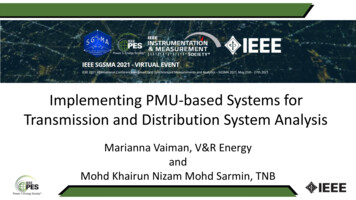
Transcription
Implementing PMU-based Systems forTransmission and Distribution System AnalysisMarianna Vaiman, V&R EnergyandMohd Khairun Nizam Mohd Sarmin, TNB
Contents1. TNB’s Experience Deploying a PMU-Based EMS SystemMohd Khairun Nizam Mohd Sarmin, TNB and Marianna Vaiman,V&R Energy2. Real-Time PMU-based Distribution System MonitoringPlatformMarianna Vaiman, V&R Energy
1. TNB’s Experience Deploying aPMU-Based EMS SystemMohd Khairun Nizam Mohd Sarmin,Head of Power System Unit at TNB ResearchandMarianna Vaiman, CEO at V&R Energy
Background Tenaga Nasional Berhad (TNB) is the largest electricity utility in Malaysia serving 9.2million customers– TNB owns 57.2% of the 26.296 MW generation installed capacity, and operates transmission networkwith a total circuit length of 23,082 km and distribution network with a total circuit length of 660,038km– TNB has recorded the highest demand of 18,566 MW and the highest energy demand of 391.85GWh/day TNB Research has been instrumental in implementing the Wide-Area Intelligent Systemprogram at TNB which explores the potential benefits of PMU– Several real-time PMU-based applications have been successfully developedTNB aims for full network observability with PMUs for voltage levels of 500 kV and 275 kVby 2021
PMU-Based EMS System TNB PMU ROSE is PMUbased EMS system developedby V&R EnergyConsists of multipleintegrated applications:– LSE POM Server– POM-Cascading Analysisapplication– POM-OPMremedial actions application– TNB PMU Viewer– TNB Cascading Viewer--LSELSE RAWPOMPMURAWLSE PMURAW PMULinear State Estimation;PMU-based State Estimator cases in Siemens PTIPSS/E .raw data format;Physical and Operational Margins Suite;Phasor Measurement Unit streaming data;Conventional State Estimator (CSE) cases;Conditioned and expanded PMU streaming dataVoltage magnitude and phase from CSE cases
LSE POM Server AnalysisFramework Multi-step process:––––Bad data detectionEvent detectionFiltering and smoothingLSE (e.g, weighted leastsquares method)– Creation of expanded andconditioned PMU data stream– Creation of PMU-based StateEstimator cases (e.g., LSE Case)
TNB PMU ROSE System Facts The conventional State Estimator (CSE) cases represent TNB system operationalmodel with over 1,500 buses/2,800 branches after topology processingSignals from 1218 PMUs / 7 PDCs are sent to TNB PMU ROSE at the rate of 25samples/secondLinear state estimation and all related computations are performed at the rateof 25 samples/secondLSE cases are created at a user-defined intervals, when bad data is detected forlonger then a certain interval, or an Event is detected by TNB PMU ROSE
Testing and Validation of TNB PMU ROSE The conventional StateEstimator (CSE) and thePMU are emulated usingreal-time data from thereal-time simulator ofOPAL-RTTNB PMU ROSE is run ona dedicated serverControl signals are sentto the real-timesimulator for remedialaction
Estimating Values Using LSE The results show that LSE(dark green line)successfully suppress theerror and provides voltageestimates with a differenceof less than 0.01%compared to the true valueSubstation with multiplePMU measurements withrandom errors and noisedenoted by yellow, lightgreen and red linesThe true value is blue line
POM – Cascading Analysis Application Performs automated cascading analysis using LSE Cases created bythe LSE POM Cascading outages are simulated based on consecutive ACcontingency analysis Two cascading scenarios are incorporated:– “Thermal” scenario“Voltage” scenario Cascading analysis may be performed with and without remedialactions
Cascading Analysis Framework There are three approaches to use OPM(Optimal Mitigation Measures) remedialactions during execution of cascadinganalysis:– (1) Determine remedial actions after anInitiating Event (IE);– (2) Determine remedial actions at the lasttier (e.g., at the end of cascading process);– (3) Determine remedial actions after an IEand at the last tier.
Cascading Analysis Cascading Viewervisualizes results ofonline cascading analysis1877 N-1 initiatingevents are analyzed inone run41 critical cascadingevents were identifiedand ranked based onseverity measured usingthe performance index
Stability Violation as a Result of Cascading A critical Initiatingevent results instability violationThe initiating eventwas tripping atransformer whichleads to overload onother branchesVoltage Unstable afterCascading Event
Effect of Remedial Actions Optimal mitigationmeasures areidentified toalleviate thisstability violationThe effect of thesemeasures can beseen in the PMUViewerVoltage Stable afterRemedial Actions
Conclusions and Future Work PMU-based EMS system was successfully deployed at TNB The LSE increases network visibility with accurate state estimates derivedbased on a set of observable PMU measurements:– PMU measurements are smoothed and bad data are filtered, and bus fault and linetrip events are detected The online cascading analysis application has been demonstrated as the usecase of LSE utilizing the PMU-based state estimator case– Fast AC contingency analysis solved with the full Newton method Remedial actions were demonstrated to be effective in alleviating thermal,voltage and stability violations Future work will involve integration with production SCADA/EMS systemand PMUs, and exploring other potential applications that will benefit fromthe LSE
Thank you!Mohd Khairun Nizam Bin Mohd SarminMarianna com
2. Real-Time PMU-based DistributionSystem Monitoring PlatformMarianna Vaiman, CEO at V&R Energy
Real-Time Distribution System Monitoring Platform Provides real-time situational awareness in order toimprove resilience of the distribution grid andenhance its reliabilityD-PMU ROSE platform consists of the hree-phase distribution linear state estimation (D-LSE)Bad PMU data detection and correctionObservability analysis for real-time situational awarenessIdentifying switching eventsArchiving and alarmingAdvanced visualization of distribution grid stateOptimal PMU placement for full distribution grid observabilityValidating model and PMU measurements
Components of D-LSEFramework Multi-step process:1.2.3.4.5.Bad data detection, correction, alarming, reportingCombination of filtering and smoothing techniquesObservability analysisThree-phase Distribution Linear State EstimationDetection of switching events (only based on PMUdata)6. Real-time system monitoring (voltage and thermal)7. Visualization, archiving Machine learning is used to improveaccuracy of event detection in real-time
Bad Data Detection and Conditioning Step 1: Data prescreening Step 2: Filtering &smoothing Step 3: LSE– Considers relationshipbetween signals– Based on WLS method
Bad Data Detection and ConditioningEstimated values after the D-LSE (filtering andweighted least squares method): YellowSource:ComEdRaw PMU values (phase B)
Observability Analysis and PMU Placement Purpose of observability analysis is to identify portions of thenetwork observable with existing PMUs– Performed in real-time– Generates observability reports Purpose of optimal PMU placement is to determine locations ofPMU installations to achieve full system observability– Off-line calculation– Creates PMU placement file
D-LSE Result –ObservabilityAnalysis &VisualizationD-PMU ROSE considers apower system network tobe observable for a givennetwork topology if voltagevector at each node can becalculated based on thePMU measurementsBlue – nodes and branchesthat are observable withplanned PMU installations(for current networktopology)Black – non-observablenodes and branches– PMU installationsSource: ComEd
Detecting and Alarming on Switching EventsSource: ComEd
Topology ChangeSource:ComEd Estimated value follow raw data during both steady state and transient conditions D-LSE identifies defined topology correctly
Alarming Event Alarm– If a switching event is identified, the Event Alarm indicator turns red Bad Data Alarm– If bad data is identified, Bad Data alarm turns red Violation Alarm– If a violation of voltage and/or thermal limit occurs, the Violation Alarmindicator turns red Multiple types of alarms might be issued simultaneously
Use of the Platform for Grid ModernizationApplications The platform consists of the following applications:– Hybrid State Estimator that uses both PMU and SCADA data– Advanced applications: FLISR (Fault Location, Isolation and Service Restoration) enhancement Volt/Var optimization DER dispatch NYSERDA demonstration project with Quanta Technology andCentral Hudson
Thank you!Marianna Vaimanmarvaiman@vrenergy.com
ComEd. Observability Analysis and PMU Placement Purpose of observability analysis is to identify portions of the network observable with existing PMUs . indicator turns red Multiple types of alarms might be issued simultaneously. Use of the Platform for Grid Modernization Applications










